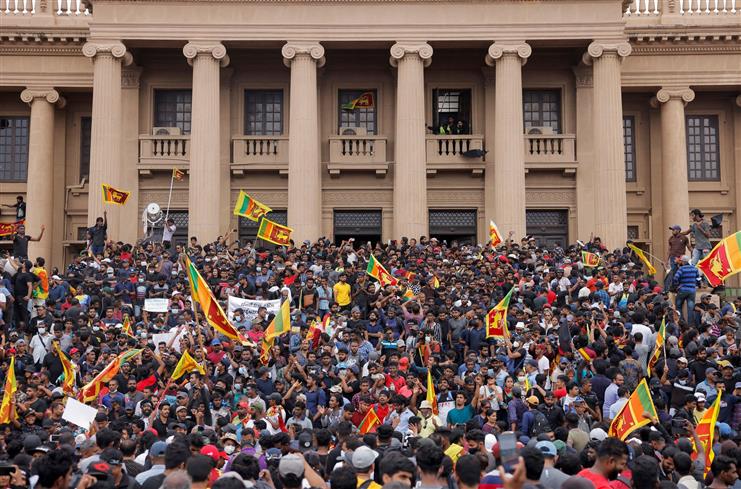Lessons from economic crisis in Sri Lanka
The spectacle from Sri Lanka, of long human and vehicular queues for petroleum products, scarcity of foodstuffs, dearth and high cost of essential items, voices of confusion, mass protests from rural areas to the capital city, Colombo, and the sack of the government that put President Gotabaya Rajapaksa on the run to the Maldives, was […]

Sri Lankan protesters
The spectacle from Sri Lanka, of long human and vehicular queues for petroleum products, scarcity of foodstuffs, dearth and high cost of essential items, voices of confusion, mass protests from rural areas to the capital city, Colombo, and the sack of the government that put President Gotabaya Rajapaksa on the run to the Maldives, was very ugly. But most importantly, it constitutes a serious lesson for many developing countries, which accumulate foreign debts and import everything from automobiles, electronic gadgets, food, fuel, to toothpicks for their society.
The protests, which started in April and culminated in the resignation of the president, were in reaction to serious economic malaise that saw a rise in inflation to about 50 per cent and the inability of the country to meet its foreign debt obligations to creditors due to dwindling revenue from tourism, the mainstay of the tiny Indian Ocean nation.
As at April 2022, when things came to a head in Sri Lanka, its foreign debt had hit $51 billion. The country is indebted to the World Bank, China, India, Asian Development Bank, Japan, and other assorted market creditors. With only $50 million in its foreign reserve, and unable to meet its debt repayment obligations, Sri Lanka lost the finances needed to import essential items to lubricate the economy – fuel, raw materials, food, and other goods. With a population of 22 million and a gross domestic product of $80 billion, according to a 2020 estimate, Sri Lanka lost its attraction to foreign capital, and the populace bore the brunt of the brutal economic situation.
The road to this economic disaster in Sri Lanka was paved with acute corruption and economic mismanagement. The country’s political elite have been embroiled in brazen acts of corruption. They appropriated state resources to satisfy their individual greed to the detriment of the welfare of the general public. This was achieved through grandiose infrastructure projects constructed through huge and senseless foreign loans. Then, there was the populist but unaffordable tax cut, which reduced revenue for government, and massive imports that drained the country’s foreign reserves.
When the economic crisis became unmanageable, China, the biggest creditor, rejected any form of concession in terms of debt restructuring, though it was obvious that debt repayment was definitely going to sound the death knell for Sri Lanka. One of such projects was the $1.1 billion Hambantota Port development in the country’s southern coast. Unable to repay, China has stepped in and taken over 43 per cent of the massive Colombo Port City development, and will be in control for 99 years.
After its long, tortuous and bitter ethnic civil war from 1983 to 2009, Sri Lanka became one of the promising Indian Ocean countries, as it effectively developed its tourism industry and agricultural sector. The civilian government that took over emphasised local production over import, but the policy was not sustained as the country slipped into massive imports and, consequently, such unsustainable debt repayment that, in 2021, the government halted the importation of chemical fertiliser for the booming agricultural sector. Though it encouraged farmers to take to local, organic fertilisers, the outcome was very unpleasant. Agriculture recorded dismal yields, making farmers turn against the government.
As a new regime is being put in place in Sri Lanka, the country is in talks with the International Monetary Fund (IMF) for a bailout; China is back on the round-table with the new leadership on how to restructure the debt; while Colombo officials are in talks with Russia for possible help. But Sri Lanka is the future of any developing country that would not wean itself from being a consumer nation to a productive economy. All developed economies deliberately built their industries to produce for local consumption and export. But many countries in Africa, including Nigeria, have failed to evolve economic strategies that would boost local production of even food and essential goods.
During the period of COVID-19 pandemic, and now, Russia’s invasion of Ukraine, the world has learned that every country must produce the chunk of what it consumes, as nature and geopolitical tension could cut supply chain of essential goods from more productive nations to import-dependent countries. Specifically, for Nigeria which has accumulated huge foreign debt burden for the construction of infrastructure, the predicament in Sri Lanka should be a lesson. It should apply caution in accessing loans from China; ensure that due diligence is done at all times.
At present, over 70 per cent of Nigeria’s income goes into debt servicing, and our foreign reserves have shrunk so much that the naira has lost its value and attraction. Inflation is out of control, agricultural production is being hampered by the dangerous spate of insecurity from north to south. We also call on the government to put in place measures that would ensure that Nigeria never becomes like Sri Lanka.
